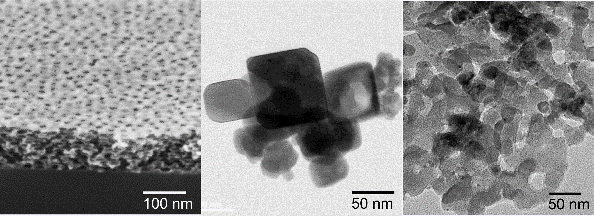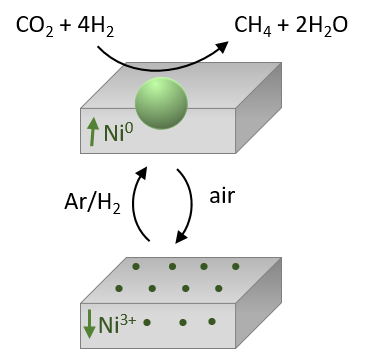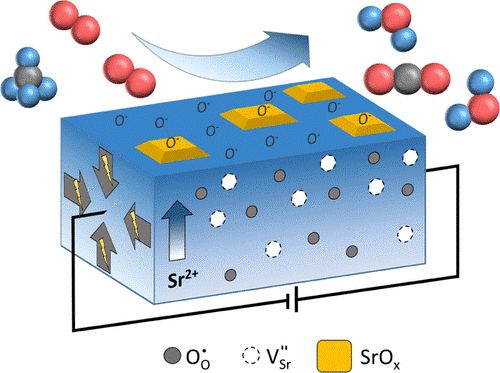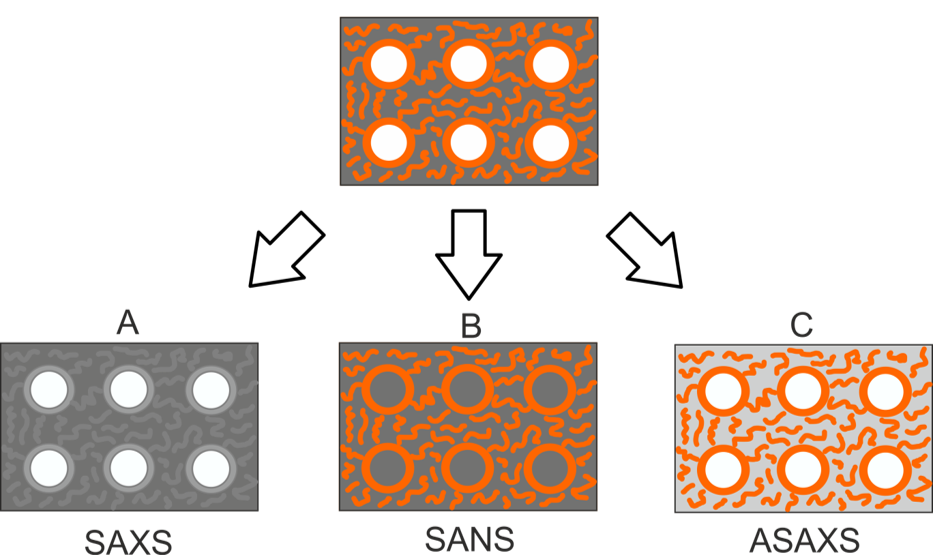Research topics
Nanostructured ceramics
The enhancement of the surface-to-volume ratio and the shortening of the diffusion path length of ionic and electronic charge carriers play a key role for the development of ceramic materials for energy conversion applications. For this reason, the preparation of nanostructured ceramics is targeted.

Nanostructured perovskite oxides are developed using colloidal synthesis approaches in form of powders, thin films and nanoparticles (Figure 1). Particular focus lies in the preparation of nanoporous structures with tunable specific surface area and pore size using different strategies with and without templating agents.
In order to exploit at best nanoporous perovskites for thermal catalysis and energy conversion applications the transport of ionic charge carriers (e.g. oxide ions and protons) in these structures needs to be carefully addressed. The unique combination of in situ X-ray diffraction with thermogravimetric experiments and mass spectroscopy allow us to understand the stong interdependency between ionic mobility and structural changes in the materials. Finally, high-temperature catalysis tests are carried out to correlate the catalytic performance with the structure-function relationships of the developed nanoporous perovskite oxides.
Regenerating supported metal catalysts

The use of nanoporous perovskite oxides as parental structure significantly improves the exsolution kinetics. In this way, better control of size, distribution and composition (for bimetallic systems) is achieved. Catalytic tests for the conversion of CO2 to added-value chemicals are performed to study the conversion and regenerating properties of exsolved catalysts on nanoporous parental supports.
Electric-field-assisted treatment of ceramics
Electric-field-assisted treatments of ceramics (e.g. flash sintering) were recently introduced to accelerate the densification and modify the grain boundary structure of ceramic materials. In our group, we use these treatments to modify the surface chemistry and defect structure of perovskite oxides (e.g. SrTiO3).

The application of electric fields of increasing voltage leads to enhanced surface segregation of Sr cations, along with the permanent formation of oxidative oxygen defects (O-). The alteration of the surface defect structure of the oxides significantly improves the catalytic properties of the materials. Electrothermal treatments can be therefore considered as an original power-to-X strategy towards the development of novel catalytic systems.
Small-angle scattering investigations of nanomaterials
Small-angle scattering methods of x-rays and neutrons (SAXS/SANS) are employed for the structural investigation of nanocomposite materials and the behavior of fluids in nanopores. Previous works dealt with the understanding of sulfur impregnation and distribution in nanoporous carbon materials for the development of Li-S battery cathodes exploiting the contrast matching method. More recently, in cooperation with external partners we investigated the structure of polymer-ceramic composites for tyre reinforcement.

Regarding the field of fluids in nanopores, we recently developed a novel in situ approach for the investigation of gas-liquid phase transition in confinement, based on the combination of anomalous SAXS and XANES during gas physisorption. Differently than contrast-matching-based techniques, this method allows for the first time the direct investigation of the adsorbate phase evolution in confinement, providing a new perspective in the investigation of matter confined in nanopores.
(Chemical Engineering Journal 2021; ACS Energy Materials 2018; Langmuir 2017)
